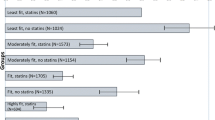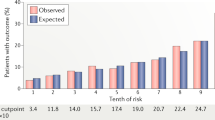Summary
Until the mid 1980s, secondary prevention of coronary atherosclerosis focused primarily on early ambulation, exercise training, and a ‘prudent’ diet. These regimens generally resulted in improved functional capacity, reduced myocardial demands at submaximal workrates, and modest decreases in cardiovascular mortality. However, reinfarction rates and the course of atherosclerotic heart disease remained largely unchanged with traditional treatment or usual care. Contemporary studies now suggest that multifactorial risk factor modification, and especially more intensive measures to control hyperlipidaemia with diet, drugs, and exercise, may slow, halt, and even reverse the progression of atherosclerotic coronary artery disease. Added benefits include a reduction in anginal symptoms, decreases in exercise-induced myocardial ischaemia, fewer recurrent cardiac events, and a diminished need for coronary revascularisation procedures. Several mechanisms may contribute to these improved clinical outcomes, including partial (albeit small) anatomic regression of coronary artery stenoses, a reduced incidence of plaque rupture, and improved coronary artery vasomotor function. These findings suggest a new paradigm in the treatment of patients with coronary artery disease.
Similar content being viewed by others
References
Hubbard JD, Inkeles S, Barnard RJ. Nathan Pritikin’s heart [letter]. N Engl J Med 1985; 313: 52
Arntzenius AC, Kromhout D, Barth JD, et al. Diet, lipoproteins, and the progression of coronary atherosclerosis: The Leiden Intervention Trial. N Engl J Med 1985; 312: 805–11
Blankenhorn DH, Johnson RL, Mack WJ, et al. The influence of diet on the appearance of new lesions in human coronary arteries. JAMA 1990; 263: 1646–52
Roberts WC. Extreme hypercholesterolemia = malignant atherosclerosis. Am J Cardiol 1984; 54: 242–3
Roberts WC. Factors linking cholesterol to atherosclerotic plaques. Am J Cardiol 1988; 62: 495–9
Roberts WC. Atherosclerotic risk factors — are there ten or is there only one? Am J Cardiol 1989; 64: 552–4
Roberts WC. Lipid-lowering therapy after an atherosclerotic event. Am J Cardiol 1989; 64: 693–5
Vogel RA. Comparative clinical consequences of aggressive lipid management, coronary angioplasty and bypass surgery in coronary artery disease. Am J Cardiol 1992; 64: 1229–33
Levy RI, Brensike JF, Epstein SE, et al. The influence of changes in lipid values induced by cholestyramine and diet on progression of coronary artery disease: results of the NHLBI Type II Coronary Intervention Study. Circulation 1984; 69: 325–37
Blankenhorn DH, Nessim SA, Johnson RL, et al. Beneficial effects of combined colestipol-niacin on coronary atherosclerosis and coronary venous bypass grafts. JAMA 1987; 257: 3233–40
Frick MH, Elo O, Haapa K, et al. Helsinki heart study: primary-prevention trial with gemfibrozil in middle-aged men with dyslipidemia. N Engl J Med 1987; 317: 1237–45
Kane JP, Malloy MJ, Ports TA, et al. Regression of coronary atherosclerosis during treatment of familial hypercholesterolemia with combined drug regimens. JAMA 1990; 264: 3007–12
Brown G, Alberts JJ, Fisher LD, et al. Regression of coronary artery disease as a result of intensive lipid lowering therapy in men with high levels of apolipoprotein B. N Engl J Med 1990; 323: 1289–98
Blankenhorn DH, Azen SP, Kramsch DM, et al. Coronary angiographic changes with lovastatin therapy. The monitored atherosclerosis regression study (MARS). Ann Intern Med 1993; 119: 969–76
Waters D, Higginson L, Gladstone P, et al. Effects of monotherapy with an HMG-CoA reductase inhibitor on the progression of coronary atherosclerosis as assessed by serial quantitative arteriography: the Canadian Coronary Atherosclerosis Intervention Trial. Circulation 1994; 89: 959–68
Scandinavian Simvastatin Survival Study Group. Randomized trial of cholesterol lowering in 4444 patients with coronary heart disease: the Scandinavian Simvastatin Survival Study (4S). Lancet 1994; 344: 1383–9
Watts GF, Lewis B, Brunt JNH, et al. Effects on coronary artery disease of lipid-lowering diet, or diet plus cholestyramine in the St. Thomas’ Atherosclerosis Regression Study (STARS). Lancet 1992; 339: 563–9
Hunninghake DB, Stein EA, Dujovne CA, et al. The efficacy of intensive dietary therapy alone or combined with lovastatin in outpatients with hypercholesterolemia. N Engl J Med 1993; 328: 1213–9
Superko HR, Krauss RM. Coronary artery disease regression: Convincing evidence for the benefit of aggressive lipoprotein management. Circulation 1994; 90: 1056–69
Ornish D, Brown SE, Scherwitz LW, et al. Can lifestyle changes reverse coronary heart disease? Lancet 1990; 336: 129–33
Barnard ND, Scherwitz LW, Ornish D. Adherence and acceptability of a low-fat, vegetarian diet among patients with cardiac disease. J Cardiopulmonary Rehabil 1992; 12: 423–31
Ornish D. Can life-style changes reverse coronary atherosclerosis? Hosp Pract 1991; May 15: 123–32
Whitney EJ, Hantman RK, Ashcom TL, et al. Reversibility of fixed atherosclerotic lesions with aggressive risk factor modification. Mil Med 1991; 156: 422–9
Schuler G, Hambrecht R, Schlierf G, et al. Regular physical exercise and low-fat diet: effects on progression of coronary artery disease. Circulation 1992; 86: 1–11
Hambrecht R, Niebauer J, Marburger C, et al. Various intensities of leisure time physical activity in patients with coronary artery disease: effects on cardiorespiratory fitness and progression of coronary atherosclerotic lesions. J Am Coll Cardiol 1993; 22: 468–77
Haskell WL, Alderman EL, Fair JM, et al. Effects of intensive multiple risk factor reduction on coronary atherosclerosis and clinical cardiac events in men and women with coronary artery disease: the Stanford Coronary Risk Intervention Project (SCRIP). Circulation 1994; 89: 975–90
Gould KL, Ornish D, Scherwitz L, et al. Changes in myocardial perfusion abnormalities by positron emission tomography after long-term intense risk factor modification. JAMA 1995; 274: 894–901
Levine GN, Keaney JF, Vita JA. Cholesterol reduction in cardiovascular disease: clinical benefits and possible mechanisms. N Engl J Med 1995; 332: 512–21
Brown BG, Zhao X-Q, Sacco DE, et al. Lipid lowering and plaque regression: new insights into prevention of plaque disruption and clinical events in coronary disease. Circulation 1993; 87: 1781–91
Little WC, Constantinescu M, Applegate RJ, et al. Can coronary angiography predict the site of a subsequent myocardial infarction in patients with mild to moderate coronary artery disease? Circulation 1988; 78: 1157–66
Little WC, Gwinn NS, Burrows MT, et al. Cause of acute myocardial infarction late after successful coronary artery bypass grafting. Am J Cardiol 1990; 65: 808–10
Treasure CB, Klein JL, Weintraub WS, et al. Beneficial effects of cholesterol-lowering therapy on the coronary endothelium in patients with coronary artery disease. N Engl J Med 1995; 332: 481–7
Anderson TJ, Meredith IT, Yeung AC, et al. The effect of cholesterol lowering and antioxidant therapy on endothelium-dependent coronary vasomotion. N Engl J Med 1995; 332: 488–93
Weintraub WS, Boccuzzi SJ, Klein L, et al. Lack of effect of lovastatin on restenosis after coronary angioplasty. N Engl J Med 1994; 331: 1331–7
Kahn JK. Reversing coronary atherosclerosis. Postgrad Med 1993; 94: 50–65
NCEP-II. Expert panel on detection, evaluation and treatment of high blood cholesterol in adults: summary of the second report of the national cholesterol education program (NCEP) expert panel on detection, evaluation, and treatment of high blood cholesterol in adults. JAMA 1993; 269: 3015–23
Author information
Authors and Affiliations
Rights and permissions
About this article
Cite this article
Franklin, B.A., Kahn, J.K. Delayed Progression or Regression of Coronary Atherosclerosis with Intensive Risk Factor Modification. Sports Med 22, 306–320 (1996). https://doi.org/10.2165/00007256-199622050-00004
Published:
Issue Date:
DOI: https://doi.org/10.2165/00007256-199622050-00004




